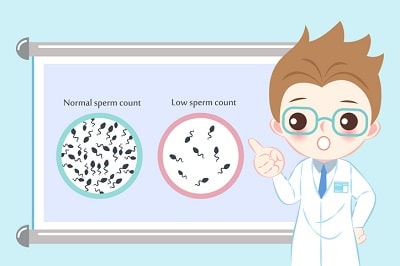The term “sperm count” refers to the number of sperm cells present in a man’s semen. Sperm counts, in addition to indicating overall health status, have important implications for male fertility. One of the most common concerns that men have regarding low testosterone is the impact that this hormonal imbalance will have on their sperm counts.
If you are an American man worried about your sperm counts, you are right to be concerned. The authors of one recent study who looked at the decline in sperm counts among men in the US and abroad concluded that sperm counts have been declining rapidly in these populations for decades. In their press release, the experts wrote:
“This study is an urgent wake-up call for researchers and health authorities around the world to investigate the causes of the sharp ongoing drop in sperm count.”
The physiological reality of the relationship between testosterone and sperm production is complex. Here, we will delve into the details to explore how testosterone impacts sperm counts and what you can do to optimize your hormonal health for long-term sexual vitality.
How Does Testosterone Affect Fertility in Men?
As the primary androgen (male sex hormone), testosterone plays a central role in maintaining male fertility. In contrast to women, who usually go through menopause around the age of 40 and lose the ability to become pregnant, healthy men produce sperm for the entirety of their lives – meaning that, even late into life, a man is theoretically still fertile.
One of the main reasons that fertility declines as men move through life is the steady drop-off in testosterone levels that typically occur over time. Following a period of maximum testosterone production in his late teens or early 20s, a man’s circulating supply of testosterone falls by 1% on average each year. This means that the average 70-year-old may have roughly half the amount of testosterone in his blood than that of a young man in his physical prime.
The chart below shows the average rate of falling testosterone levels across time.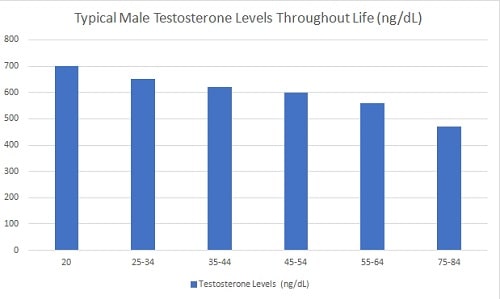
Lowered sperm production is a primary symptom of testosterone deficiency, defined by inadequate testosterone production in the testes. In the section below, we will examine the reasons how low testosterone levels can impair sperm production and lower sperm counts.
The Sperm Production Process: How Is Sperm Produced?
To produce sperm, the body relies on a complex interplay between various hormones, glands, and structures, with testosterone and the testes playing a critical role alongside other components. In clinical settings, the sperm production process is referred to as “spermatogenesis.” The hypothalamic-pituitary-gonadal axis (HPG axis) is the lynchpin of spermatogenesis, within which the related hormones act in concert to produce the ultimate end-product of viable sperm cells.
Through several hormone-mediated steps that make up the 2 ½-month sperm production process, germ cells located in the testes (the organs where testosterone is produced) transform into spermatozoa, commonly referred to simply as “sperm.” At the final stage of production, the sperm shift to the vas deferens, where they can remain for weeks. When mixed into a solution known as semen, the fully-formed spermatozoa are ready to penetrate and fertilize a female egg.
Common Factors That Affect Sperm Count
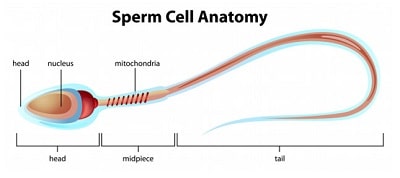 Earlier, we illustrated the decline in testosterone levels over time. In addition to testosterone levels dropping in the US and other developed nations, sperm counts are also dramatically declining. In fact, according to recent research, the average sperm count for the average American man has dropped by more than 50% in less than fifty years. Interestingly, no similar trends have been seen in certain developing regions like Africa, leading many endocrinologists to speculate about the underlying causes for these shifts in the advanced countries of Europe and North America.
Earlier, we illustrated the decline in testosterone levels over time. In addition to testosterone levels dropping in the US and other developed nations, sperm counts are also dramatically declining. In fact, according to recent research, the average sperm count for the average American man has dropped by more than 50% in less than fifty years. Interestingly, no similar trends have been seen in certain developing regions like Africa, leading many endocrinologists to speculate about the underlying causes for these shifts in the advanced countries of Europe and North America.
A 50% loss of sperm count is extremely disturbing for public health groups attempting to figure out how to reverse the trend and save the sexual health of an entire generation of American men. According to the top experts studying this issue, the most concerning aspect of the downward trajectory of sperm production is that it shows no sign of slowing down. Dr. Shanna H. Swan of the Icahn School of Medicine at Mount Sinai reports that “this decline is strong and continuing.” What is causing lowered sperm counts in so many men?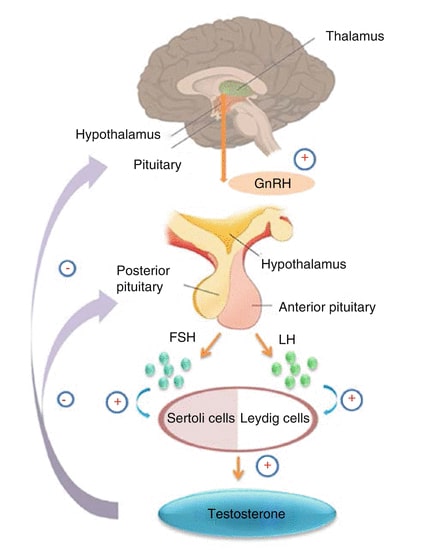
What Is Causing the Massive Decline in Sperm Counts for US Men?
A few reasons to explain the decline in sperm counts among US men might include:
- Less exercise/more sedentary lifestyle. In addition to not staying active in the gym, a large percentage of US men work in offices or other work settings that require little movement throughout the day. The COVID-19 lockdowns have likely made this lifestyle issue worse for many men. In one study, for example, on the reduction of physical activity following the COVID lockdowns, the authors report that “[physical activity] was reduced in all genders, age, body mass index (BMI)” after the social distancing and economic lockdowns that began last March. The chart below demonstrates the decrease in activity levels during quarantine measures through a comparison of physical activity rates before and after the coronavirus pandemic:
- Increasing obesity rates. Closely related to the overall lack of physical activity among an enormous percentage of the male population is the rising trend in obesity. As evidenced in the graph above, public health groups have seen a dramatic uptick in the numbers of obese men (measured by body mass index, or BMI) as a percentage of the population. Obese men have significantly lower sperm counts on average than men of a healthy weight. In fact, the findings of one study suggest that obese men have a 42% greater risk of developing low sperm counts than men at a normal BMI.Nutrition experts at the University of Chicago Medicine have identified the common food sources that are most devastating to sperm counts in men. These include, among others, soy products, processed meats such as hot dogs, high-fat dairy, and snacks containing added sugar and/or trans fats.”Endocrine disrupter” is a designation for chemicals that impair hormone function and, in consequence, reduce male fertility. BPA is just one of many endocrine disrupters that are commonly encountered in modern life.
- Low testosterone. Below, we will take an in-depth look into the connection between low testosterone and sub-optimal sperm production.
- Prescription medications. Certain drugs such as steroids, cancer drugs for chemotherapy, ulcer drugs, and some antibiotics are known to decrease sperm counts.
- Chemical exposure. In addition to certain foods themselves, pesticides, bisphenol-A (BPA), and other contaminants added during food production also significantly impair sperm production. BPA – a chemical that is universally found in the modern urban environment and which mimics the effects of estrogen in the body — is particularly devastating for sperm counts.
- Poor diet. The standard American diet is chock full of added synthetic ingredients such as preservatives and extra sugar (often in the form of harmful high-fructose corn syrup) while offering little in the way of nutrition.
What Is the Connection Between Low Testosterone and Infertility?
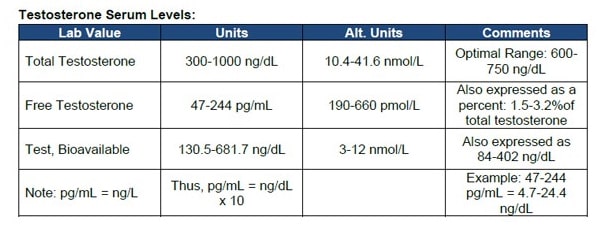 “Hypogonadism” (sometimes called “low T”) is a condition — often affecting aging men but increasingly common in younger age groups — in which the testes fail to produce an adequate supply of testosterone for distribution throughout the body.
“Hypogonadism” (sometimes called “low T”) is a condition — often affecting aging men but increasingly common in younger age groups — in which the testes fail to produce an adequate supply of testosterone for distribution throughout the body.
Healthy testosterone levels vary depending on individual factors with “total” testosterone levels in the range of 300-1,000 nanograms per deciliter (ng/dL) indicating normal amounts of the hormone.
Normal “free testosterone” (also called “bioavailable testosterone”) levels for men fall within 47-244 picograms per milliliter (pg/mL).
How Testosterone Increases Sperm Counts in Men With Low T
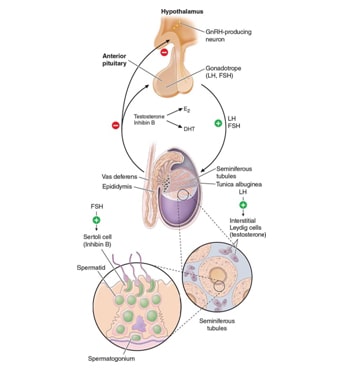 While not every case of testosterone deficiency results in lowered sperm counts, many men with deficiencies (as measured by blood tests and compared to the reference ranges in the chart above) also show the signs of decreased sperm counts as well as reductions in sperm quality.
While not every case of testosterone deficiency results in lowered sperm counts, many men with deficiencies (as measured by blood tests and compared to the reference ranges in the chart above) also show the signs of decreased sperm counts as well as reductions in sperm quality.
Testosterone is intricately involved in — and necessary for — the sperm production process. Throughout spermatogenesis, testosterone interacts with the following components of the reproductive system and various hormones to direct the sperm production process:
- Androgen receptors (AR) in the testes.
- Sertoli cells.
- luteinizing hormone (LH).
- Leydig cells.
- Vascular endothelial cells.
- Follicle-stimulating hormone (FSH).
Critically, the importance of testosterone’s role in spermatogenesis is illustrated by the fact that testosterone levels in the testes – again, where sperm production occurs – is 25-125 times higher than testosterone levels in the blood and other tissues.
Does Stopping Testosterone Replacement Therapy Have Negative Effects on Men’s Sperm Counts?
For men with low testosterone who are receiving testosterone replacement therapy (TRT), abruptly discontinuing doses of testosterone may have a negative impact on fertility. Too much or too little testosterone is potentially harmful to sperm counts. Accordingly, in order to prevent complications that could have long-term impacts on your fertility, always consult with an experienced endocrinologist (hormone doctor) before beginning or terminating TRT.
Strategies for Men to Boost and Maintain High Sperm Counts Throughout Life
 Researchers interested in optimizing hormone health for men have discovered – and subsequently vetted through research – several strategies that any man can use to boost and maintain healthy sperm counts throughout his life. Here are the proven ways to keep your sperm counts in the ideal range:
Researchers interested in optimizing hormone health for men have discovered – and subsequently vetted through research – several strategies that any man can use to boost and maintain healthy sperm counts throughout his life. Here are the proven ways to keep your sperm counts in the ideal range:
- Eliminate processed or inorganic foods from your diet. Most importantly, utilize BPA-free packaging whenever possible, cut down on soy and dairy intake, and eat more lean meats and fresh fruits and vegetables.
- Lose weight (for overweight men) in a controlled, healthy fashion through improved diet (see above) and increased exercise (see below).
- Get more exercise. The evidence is crystal-clear that men who exercise regularly have higher sperm counts.
- Minimize stress through meditation, breathing techniques, cognitive behavioral therapy (CBT), or other stress-reduction methods.
- Quit smoking and limit alcohol intake to a maximum of 1-2 drinks per day.
- Consider taking cold showers. Excessive heat exposure, such as occurs during a hot shower, can dampen sperm production. A mounting body of evidence, on the other hand, suggests that cold therapies — including cold showers – can improve both sperm counts and sperm quality.
- Supplement with compounds proven to boost sperm counts. Examples of these include D-aspartic acid (D-AA), zinc, ashwagandha, vitamin C, and vitamin D. Strong evidence suggests that D-AA, in particular, may boost sperm count as well as enhance sperm quality.
If you have any of the risk factors described here for low sperm counts, the first step to protecting your fertility is to schedule an appointment with an expert endocrinologist. When you meet, your doctor will discuss your personal medical history, perform a physical evaluation, and, if he or she suspects a low sperm count, order the proper testing.
Depending on the results, your doctor may advise that you begin a testosterone replacement therapy (TRT) regimen. Recovering a healthy sperm count is possible with the right lifestyle changes and medical interventions – including, when appropriate, TRT.

